Military history mural at Small Arms Building will be moved to building facade
Update
The mural has been moved to the inside of the Small Arms Building.
[End of update]
Mural at Small Arms Building
I have spoken about the mural at the front of the Small Arms Building in previous posts including this one:
Long Branch Rifle Ranges, Small Arms Building, and the Arsenal Lands
The mural has been discussed in other posts as well.
Click here to access previous posts about mural at Small Arms Building >

Military history mural at front of Small Arms Building, which was designated as a heritage site under the Ontario Heritage Act in 2009, as a result of a community initiative led by Jim Tovey who now serves as Ward 1 Councillor in Mississauga. Jaan Pill photo
In the next while, the mural will be moved to the facade of the Small Arms Building. Ward 1 Councillor Jim Tovey has informed me of the planned move some time back.
Click here to access Heritage Mississauga overview of Small Arms Ltd. story >
Standing straight
The photo on the right shows the three-panel mural as it appeared some time back around the time that it was installed. At first it stood perfectly perpendicular to the ground, like a soldier at attention.
However, the supporting structure holding the mural upright is not able to deal with strong winds, which means that, as time has passed, the structure has been leaning forward or backward and occasionally has ended up flat upon its face, following windstorms in the area.
Currently, the structure is leaning backward, as some wires have been installed to enable the mural to remain in place with some semblance of uprightness, rather than being thrown to the ground in response to strong gusts of wind.
Leaning backwards, or sometimes forwards

The question of uprightness, as it relates to the Small Arms Building military mural, brings to mind some recent work on the north side of Villa Road in Long Branch. Here is a structure that is perpendicular, and that is destined to stay that way for quite a while. Jaan Pill photo

Occasionally, physical forces have shaped a baffle into a sculptural form reminiscent of the hull of a wooden boat. Jaan Pill photo
When it’s leaning backward, the desire, on the part of the viewer, to look closely at the mural is diminished.
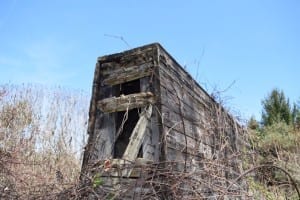
Photo of same baffle as the one in previous photo (directly above), but taken on another day, and under different lighting and weather conditions. Lines and gradations of tone, highlighted in this particular photo, as they relate to what is evident to a person observing the visual elements of the baffles, are of interest. Jaan Pill photo
We are used to looking at paintings on walls, under conditions where the paintings are perpendicular to the floor or ground, rather than leaning away from the viewer.
The mural is a high-quality work of art
In previous posts about the mural, I’ve discussed the images that are on view, and have offered my assessment of the quality of the display. In my view, the quality of the three-part mural in from of the Small Arms Building is excellent, as I have noted in the posts.
That is, the mural is well-researched, and demonstrates an engaging gestural quality of artwork. As well, the stylized, cartoon-like form of representation makes for an effective form of communication. The story is told quickly, and evocatively. There is much in the imagery that the viewer can fill in on her or his own, based on her or his own, unique life experiences.
I’ve also advanced the concept that, in walking in the area around Lakeshore Road East and Dixie Road, a person can picture that he or she embarked upon a visit – in my case, hundreds of visits, speed out over many years of walks in the area – to an informally arranged outdoor art gallery or outdoor museum. For example, the roadway signage in the area, some of it going back many decades, is similarly stylized and, of necessity, serves to communicates its respective messages quickly and effectively. The signage is similar in style to the imagery in the military history mural at Dixie and Lakeshore Road.
With regard to signs and signage, a May 21, 2015 CBC article, entitled “Did early man communicate with cave signs?”, comes to mind.
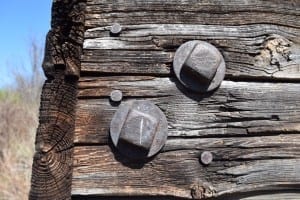
The design of the baffles is uniform; structural details such placement of bolts appear to be identical at all of the baffles. Jaan Pill photo
The area is not an officially constituted outdoor art gallery, however, of course; nor is it an officially constituted outdoor museum.
The baffles remain in place, the remnants of a rifle range
The baffles south of the Small Arms Building have about them the air of a museum, and the air of an art gallery, but they are not in a museum, or an art gallery. They are standing in place, in what used to be a rifle range; that is, they remain standing in place, within the physical environment within which they were built.
The baffles were constructed in 1910, or just after 1910, as I understand from the evidence-based online reference material that is available. The latter material also notes that the area was a location for emergency postwar housing, with the result that children were known to have enjoyed playing hide-and-seek around the baffles in the postwar years.
Click here to access previous posts about the baffles >
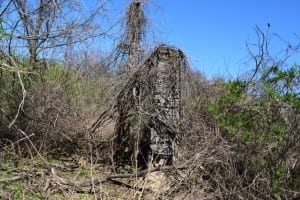
In early May, a burst of green emerges in the presence of the baffles. The thorns and tangled underbrush to a great extent serve to keep people clear. Jaan Pill photo
One can say that, in visiting the baffles, a person is not in an art gallery kind of setting – although the baffles do qualify as quintessential installation pieces, if one is inclined to view them from an art-oriented perspective.
Art Gallery of Mississauga
There’s a place for art galleries, and there’s a place for museums. I am, by way of example, impressed with the quality of programming at the Art Gallery of Mississauga:
MPP Charles Sousa announces investment to kick-start Lakeview project on Mississauga waterfront
The latter art gallery addresses themes of relevance to the presence of baffles on rifle ranges. It’s worth a person’s while to visit the Art Gallery of Mississauga. There is much to learn in such a setting, given the quality of the programming.
Encountering the baffles in the present moment
What matters is the here and now, the present moment. In the present moment, you can explore the area, and encounter it as it is. You can also approach it from the context of reality tourism. That’s a concept that appeals to me, as I’ve noted in a previous blog post:
Displacing Desire (2006) and The Ethics of Sightseeing (2011)
That is to say, if I had to choose among conceptualizing the Small Arms Building and Arsenal Lands as an outdoor art gallery, an outdoor museum, or as a destination for reality tourism, I would choose reality tourism.
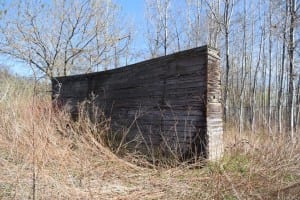
A baffle that has been twisted out of shape has the capacity to demonstrate a strong presence. Jaan Pill photo
Options for approaching a visit to the baffles
However, as I think about it further, I would say that reality tourism isn’t that much better than the other two options. The best way – from my perspective, that is, which may not be the same as yours – is to approach each visit to the baffles from the vantage point of mindfulness – that is, from the vantage point of what is evident to a person in the present moment.
History
I found it of interest to speak with Lou Klevinas of Mississauga and Collingwood at the start of the May 3, 2015 Jane’s Walk at the Small Arms Building.
Lou Klevinas remarked that he found the story of the Small Arms Building – all of the history associated with it – fascinating. He added that history, as it was taught in high school, was not so interesting.
I feel the same way. I have an interest in history, but it’s an interest that developed many years after high school, as a response to a particular situation – the Parkview School story at 85 Forty First Street Long Branch where I live – that I encountered some years ago.
Learning history in high school? I don’t know.
I imagine that learning history in high school is of value if students are given some problem to solve, and they have to learn something about history – by experiencing things related to history in the world of physical reality, not just in the digital realms – in order to solve the problem.
That might be one way for a person to tune into history. If it’s part of a conversation, part of some problem-solving exercise, as opposed to a lecture, there might be some value in learning history in elementary school and high school.
I also much appreciate the fact that, on the whole, Canadians tend to be low key about history. There isn’t a sense of head-strong nationalism. Discussions related to the interpretation of history tend to be relaxed and respectful. Past military victories, as by way of some key battles in the War of 1812, which cut short the attempt, on the part of the United States, to occupy Upper and Lower Canada, are pretty much taken in stride:
Another post, regarding the interpretation of Canadian history, is one entitled:
What can we learn about evidence-based practice when we read about Tecumseh?
With regard to Canadian military history, a May 8, 2015 CBC article, entitled: “Old vets, old values underline Dutch regard for Canada’s WWII liberators,” comes to mind.
Click on the images to enlarge them; click again to enlarge them further
Click here to access previous posts related to military history >
As I worked on this post, I read three wordless graphic novels from the 1920s, and found them of relevance:
The Sun; The idea; Story Without Words: Three Graphic Novels (2009)
A blurb for the above-noted book, at the Toronto Public Library, reads:
“Rich in symbolism, these compelling graphic novels feature more than 200 starkly beautiful woodcut illustrations. The passionate, dynamic narratives include The Sun, a somber exploration of one man’s struggle with destiny; The Idea, a depiction of the triumph of an artistic concept over attempts at its suppression; and Story Without Words, a tale of thwarted romance.
“Belgian-born Frans Masereel illustrated the works of Tolstoy, Zola, and Oscar Wilde, but he made the greatest impact with his wordless novels. These three stories, dating from the early 1920s, reflect the German Expressionist revival of the art of the woodcut. Precursors to today’s graphic novels, they also represent a centuries-old tradition of picture books for unschooled audiences. Masereel combines allegory and satire in his explorations of love, alienation, and artistic creation. Thomas Mann praised these striking Expressionistic images as ‘so compelling, so deeply felt, so rich in ideas, that one never tires of looking at them.’ ”
I learned of the book through a May 2, 2015 New York Times Magazine article entitled: “Letter of Recommendation: Frans Masereel’s ‘The City.’ ”

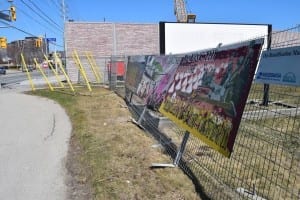
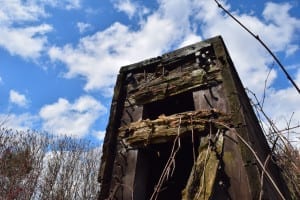
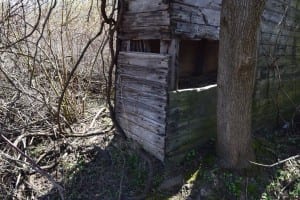
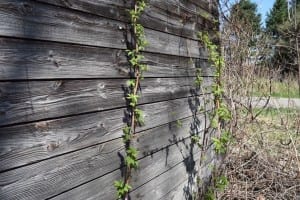
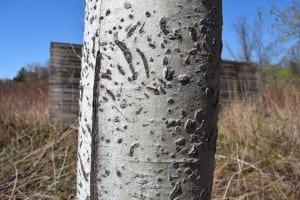
Leave a Reply
Want to join the discussion?Feel free to contribute!